We’re about 4 years into the deployment of 5G. We’re past the early adoption phase and it’s now a maturing technology. It took 5G four years to get to 1B users. That’s much faster than the 7 years for 4G.
And we now know what use cases make sense for 5G in practice. It’s not the speculation it used to be. We know the use cases that are getting traction. They follow from the big benefits of 5G, which are usually listed as
- Data
- Downlink
- Uplink
- Latency
- Reliability
The simpler version of this is “consumers like 5G, businesses need 5G”. For example:
- Consumers are using 5G in a big way for video, especially short video (which was surprising). And also, for more interactive entertainment (gaming, VR). The fast download speeds let you do lots of HD video. The fast upload speeds let you do live streaming. The low latency is also important for gaming and interactive entertainment.
- Businesses are using 5G for digital transformation. High speed and bandwidth plus low latency is the key to digitizing factories, transportation, and other big operational businesses. The sensors plus the connectivity get the whole business tied into the cloud and all its increasing capabilities. But the digital transformation of enterprises takes a long time, especially for operationally complicated businesses. In practice, 5G for business has been a lot about building private networks (about 65,000 5G projects underway) and deploying a lot of IoT sensors.
That’s a simple summary for 5G.
But Huawei is now rolling out 5.5G (also called 5G Advanced or 5G-A). This is a 10x improvement in speed over 5G. And we’re now getting some early looks at use cases for 5.5G. Overall, it looks like it is going to be another big year in digital infrastructure.
This article is a quick summary of what I am watching for. And where the big benefits of 5G and 5.5G are.
Five Scenarios Where 5G and 5.5G Create Big Value
I was recently in Dubai for the Mobile Broadband Forum. That’s a +14-year-old annual event that provides a good look at the latest in mobile infrastructure. It tends to be a good place to see case studies on what mobile carriers are doing around the world.
In the next couple articles, I going to detail some 5G and 5.5G case studies from South Korea, Hong Kong, the UAE, and Saudi Arabia. This article is just going to be a short list to keep in mind for value creation.
Plus, I spent many years working in the Middle East for Prince Alwaleed. I was doing consulting projects at Dubai Internet City back in 2001-02. The city was about half the size it is today. Here are some photos from Dubai circa 2001-2 if you’re curious.

Jumeirah. Note the lack of development surrounding it.

On the river in Deira.

Consulting work at Dubai Internet City
As mentioned, 5.5G is basically a 10x increase in speed over 5G. Instead of 1 Gbps down and 100 Mbps up, it’s 10 Gbps and 1 Gbps. That lets you move tons of data quickly back and forth to the cloud, which means much more intelligence in the network.
At the Dubai conference, Cao Ming (Huawei President of Wireless Solutions) announced the launch of a full series of solutions for implementing 5.5G. Basically everything a carrier would need to upgrade. For those interested in the technical side, this includes:
- An extremely large antenna array (ELAA) that boosts a commercial 5G network’s TDD coverage and energy efficiency.
- A mm Wave AAU with +2,000 antenna elements to overcome the limitations of mm Wave.
- DIS improvements in performance and energy (so 5.5G works indoors).
Also at the conference, Huawei’s Li Peng (President of Carrier Business Group) laid out a pretty clear summary of where 5G and 5.5G are going to create large value. My summary for this article is basically from his talk (which I agree with).

The 5 scenarios for 5G and 5.5G are:
- Glasses Free 3D
- Self-Guided Vehicles
- Next Gen Manufacturing
- Cellular IoT
- Intelligent Computing Everywhere
Scenario 1: Glasses Free 3D (Which Is Really Cool)
3D without glasses is using super-fast connectivity to do real-time rendering of 2D video with generative AI. You stream a video from your smartphone (which is 2D video), which is then converted to 3D in the cloud by generative AI, which is then streamed to a device for viewing in 3D. It can be viewed on a smartphone, laptop, or tablet. And you can watch without glasses and see it is 3D (somewhat). It’s pretty cool.
This 2D-to-3D approach is not total 3D (it’s more like 70-100 degrees). It is limited by the viewing device and the quantity of data in 2D video. You also have to sit in a specific place in front of the screen as the camera needs to track your eye movements to present the 3D video correctly. So, it’s basically AI powered eye tracking plus cloud rendering applied to 2D video.
But it works. For a smartphone, you can just put a screen on top of your current smartphone at it works. Here’s what it looks like.

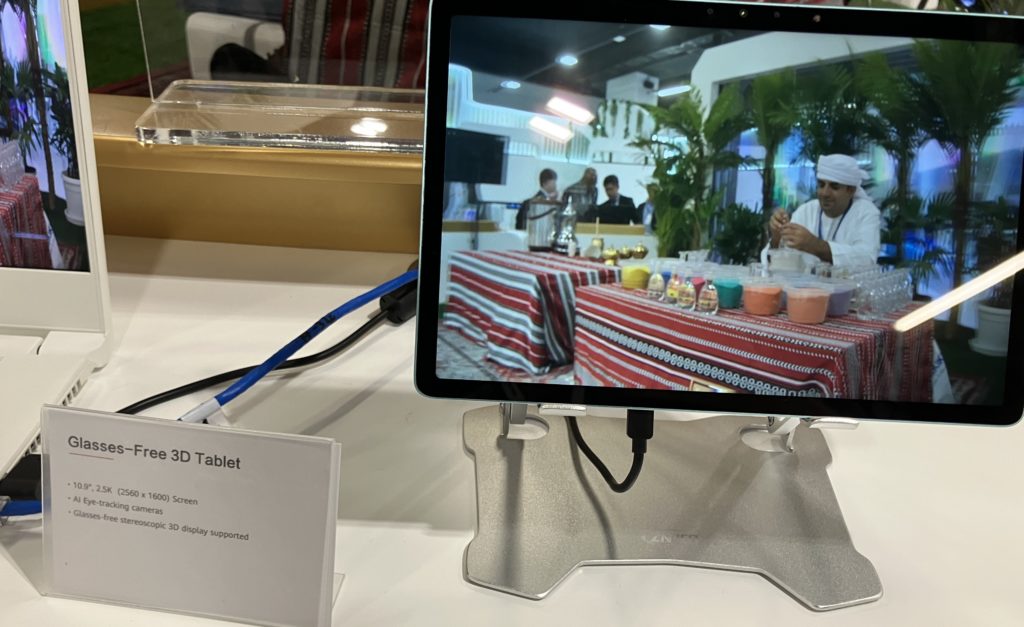
The above was a livestream that was being converted and shown on a laptop and an iPad. It’s not bad. And it plays to the strengths of 5G. You have the fast upload speed (which 4G doesn’t have) so you can do live streaming. You can send lots of data (which AI requires). And you have low latency so you can do AI generated content in the cloud and then download it fast.
5G really plays out on the consumer side in immersive and interactive entertainment, such as 3D, XR, live streaming and gaming.
But the great example which convinced me of glasses free 3D is complete 3D-to-3D video. This is when the video is filmed in 3D and then projected on special computers (see below). This basically creates a holograph that you can view from almost any angle. In the below example, you can look at all sides of the projected car. It’s fantastic. I’m buying one of these as soon as they are available.
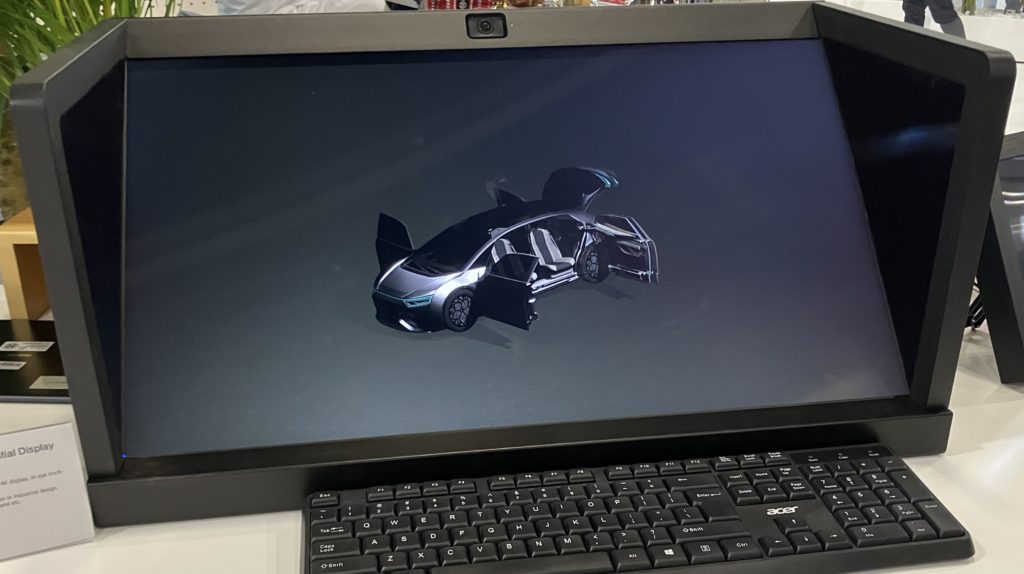
Here are links for two videos of these devices. My camera didn’t capture the 3D effect that well, but it really is pretty fantastic.
- Here is the 2D to 3D video.
- Here is the 3D video.
Glasses free 3D is a good use case for 5G and 5.5G. And 3D virtual humans are on the way. As well as XR.
For those interested in the technical side, the specs for this are 8k at 90 fps. That gets you 12k panoramic videos. And you want to get to real-time, 3D, multichannel 8k and dual eye 4k cloud rendering. And with virtual see through (VST) with less than 12 ms latency. That’s fully immersive and interactive but you need 5 to 10 Gbps. Hence, 5.5G.
Scenario 2: Self-Guided Vehicles
Transportation and self-guided vehicles have always been a big part of the 5G story. They require low latency (moving vehicles can’t have lags). And the amount of data required to safely control a car or vehicle is huge. They also require high reliability. As will be discussed in the next article, South Korea (a 5G leader) is really focused on this particular use case.
So 5G and 5.5G is about increasing the data to vehicles by 100x and making them intelligent. Vehicle-to-cloud collaboration is what gets you self-driving cars. Also, self-driving buses and other transportation vehicles.
However, they you start thinking about vehicle-to-vehicle communication and collaboration. And then vehicle-to-road communication and collaboration. Think millions of vehicles are communicating with intelligent traffic lights and road cameras. Which quickly becomes a discussion about smart cities and urban environments.
Here’s a slide from Li Peng on this. Note the data requirements.

Scenario 3: Next Generation Manufacturing. The Key to Enterprise Transformation.
This is the scenario I am most excited about.
First, you create a private 5G network for a manufacturer or other business. You put sensors everywhere. You start to gather tons of data. And then you connect it to the cloud and lots of digital and AI capabilities start to get applied. The result is:
- The enterprise becomes smart and data driven. IoT is a massive increase in data collected and analyzed in a business. Everything is increasingly running through AI and other cloud-based capabilities.
- Operations become automated. Decisions start to happen without people in the loop. Certain workflows happen and adjust automatically. At the speed of algorithms.
This is the usually first step in digitizing a manufacturing facility. And it typically starts with a 5G auxiliary production service. You create a separate facility. Then you move this into core production over time. You digitize existing capabilities and then increasingly create entirely new capabilities.
But then something else happens.
- Production becomes flexible and dynamic. Think about a typical auto manufacturing facility that needs to adjust its 10-20 production lines each year. In a digitized factory, the adjustment time can drop from weeks to days. Utilization increases, which saves money. But it also starts to become more responsive to changes in demand, so revenue can increase. Increasingly, we are even seeing parts of factories self-organize and assemble into different configurations.
- Production starts to directly interact with demand. AI is good at demand prediction. So, there is lots of data flowing between customers and production. But a flexible production system can start to make different things on demand. It can also personalize to individual users or user groups. Basically, the interactions with customers start to become two directional. Not only can production increasingly predict and personalize to demand. It can also increasingly shape demand. IoT stops being about efficiency and cost savings. And becomes more about revenue generation and creating demand.
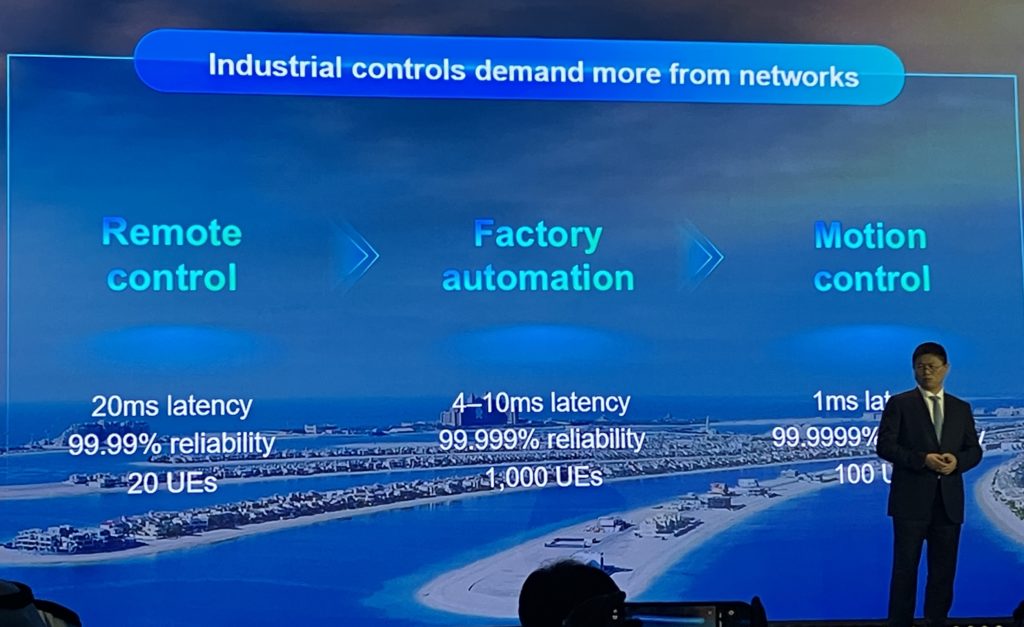
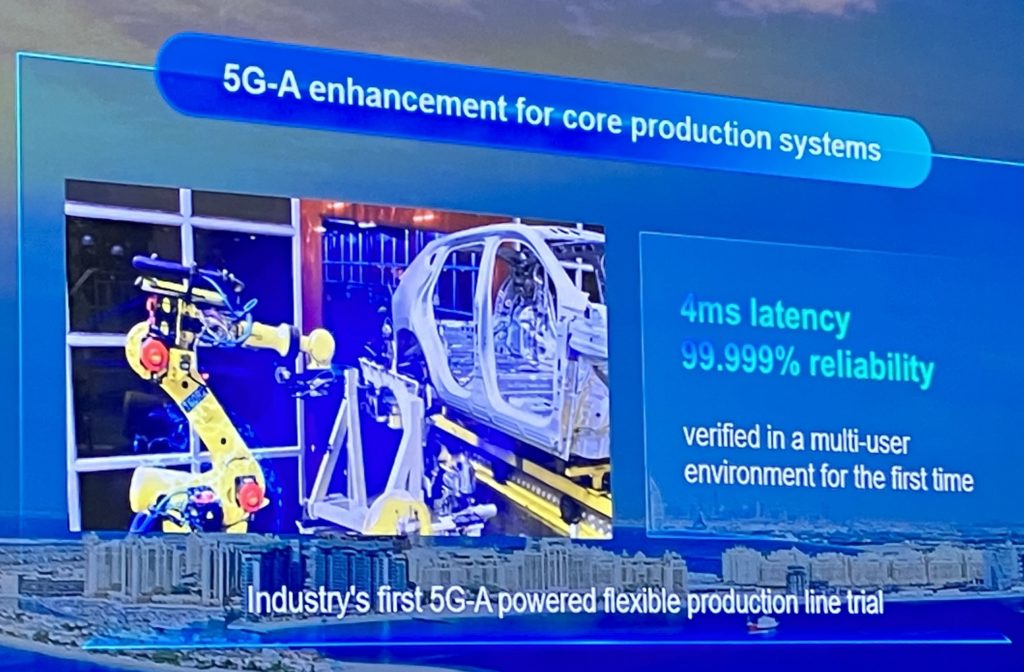
Scenario 4: Cellular IoT
This is another scenario I think is transformative. Think data streams connecting billions of devices everywhere, using cellular networks. Suddenly everything is connected to everything.
To achieve this, you need cellular IoT. And you need a range of IoT devices and capabilities.
Passive IoT is cheap and pretty easy to place everywhere. Think about little stickers you can put on every parcel in a truck. It’s cheap but it is also very limited in capabilities.
For real IoT and for what was described in Scenario 3, you want real-time cameras and other sensors with greater connectivity. But that creates cost problems when you have to deploy thousands of them. This is especially a problem for SMEs.
Here is the range of IoT capabilities you probably need.

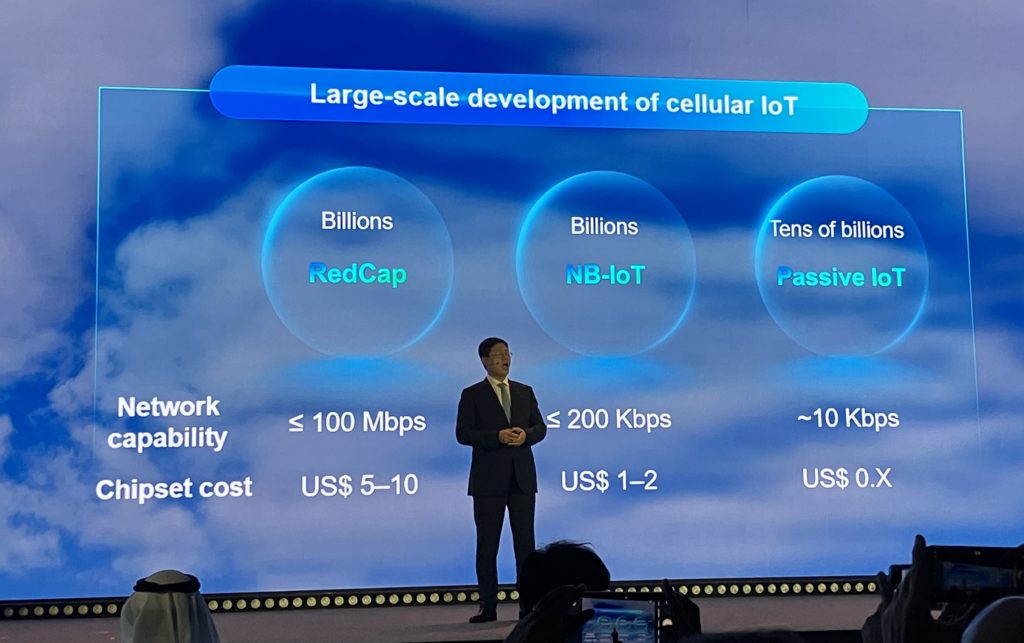
Note the chipset cost in the last slide. That’s important.
One of the cool things about 5.5G is its remote sensing capability (which 5G doesn’t have). There are “reduced capability” sensors in China (called Red Cap). There are about 50 types of these devices and they have already been deploying in China. They are taking Red Cap international this year.
Last Scenario: Intelligent Computing Everywhere
Note the below slide.
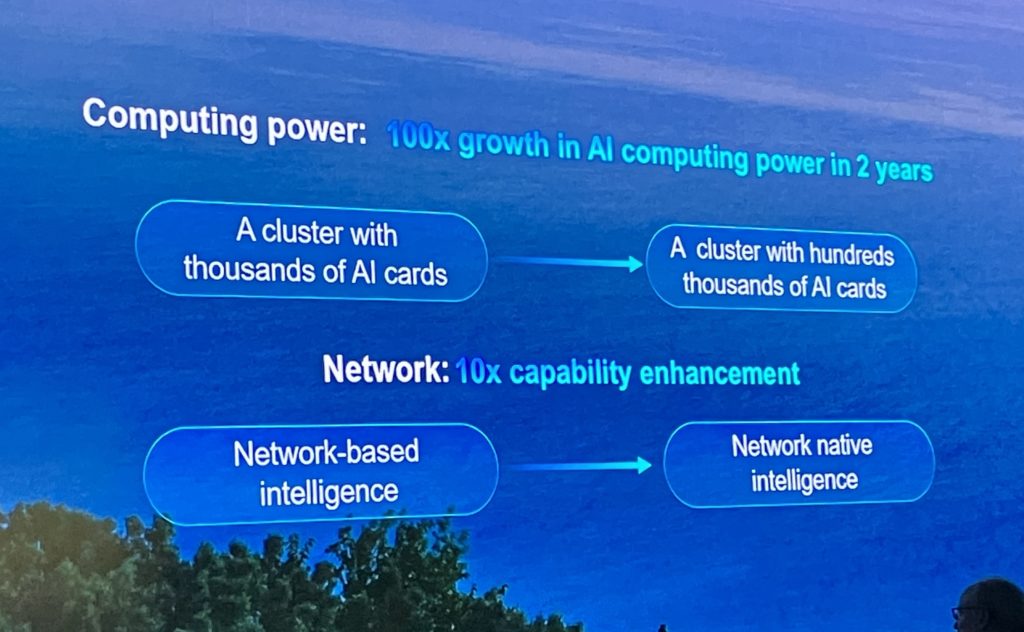
A 10x increase in network capability is coming. Networks are becoming natively intelligent.
AI will be everywhere. And you will just plug into intelligence like plugging into electricity through an outlet. Although intelligence will be running through the walls and the air. And the air interface looks like it will be dominant.
That’s pretty much how I view the future of digital infrastructure: pervasive connected networks that are natively intelligent. A lot of it will be physical but a lot will just be going through the air. And here are the specs for what future mobile networks will need to provide. This is a really good checklist to keep in mind.

For carriers this is a challenge. It means they will not only need enhanced mobile broadband (eMBB), massive machine type communications (mMTC) and ultra-reliable low-latency communication (URLLC). They will also need Uplink Centric Broadband Communication (UCBC) and Real Time Broadband Communication (RTBC).
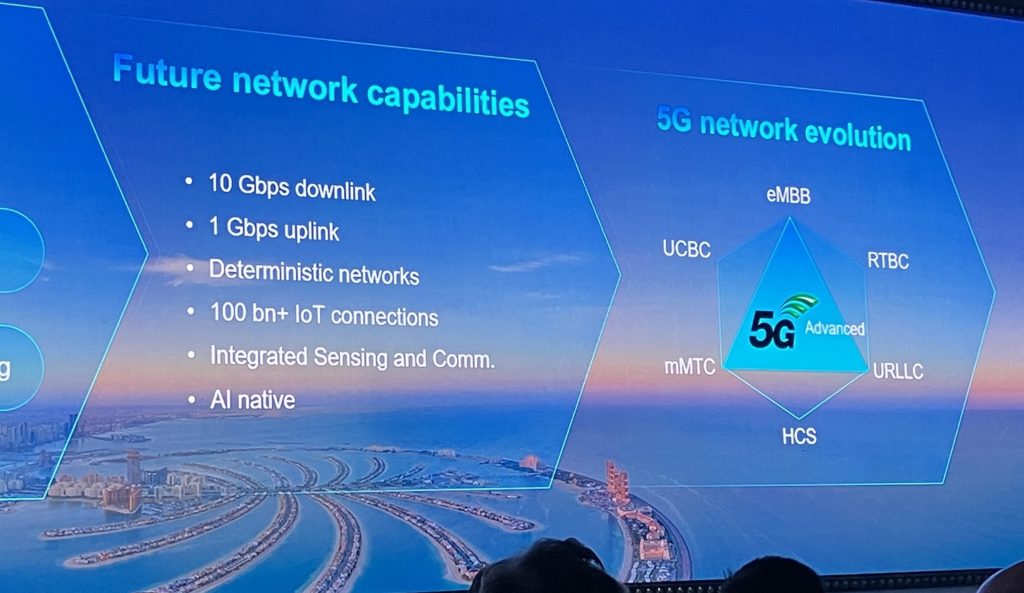
That slide is pretty much how I see the next 5-10 years.
For mobile carriers, this is good and bad news. The bad news is they are going to have to keep building. But that is pretty standard in the carrier business. The good news is that with this type of network, they can (in theory) expand into lots of services beyond connectivity. Most of them are trying to do this. And that is the focus of the next articles.

That’s it for this article. More on the way.
And just for fun, here is some more Dubai pics from 2001. – Jeff



